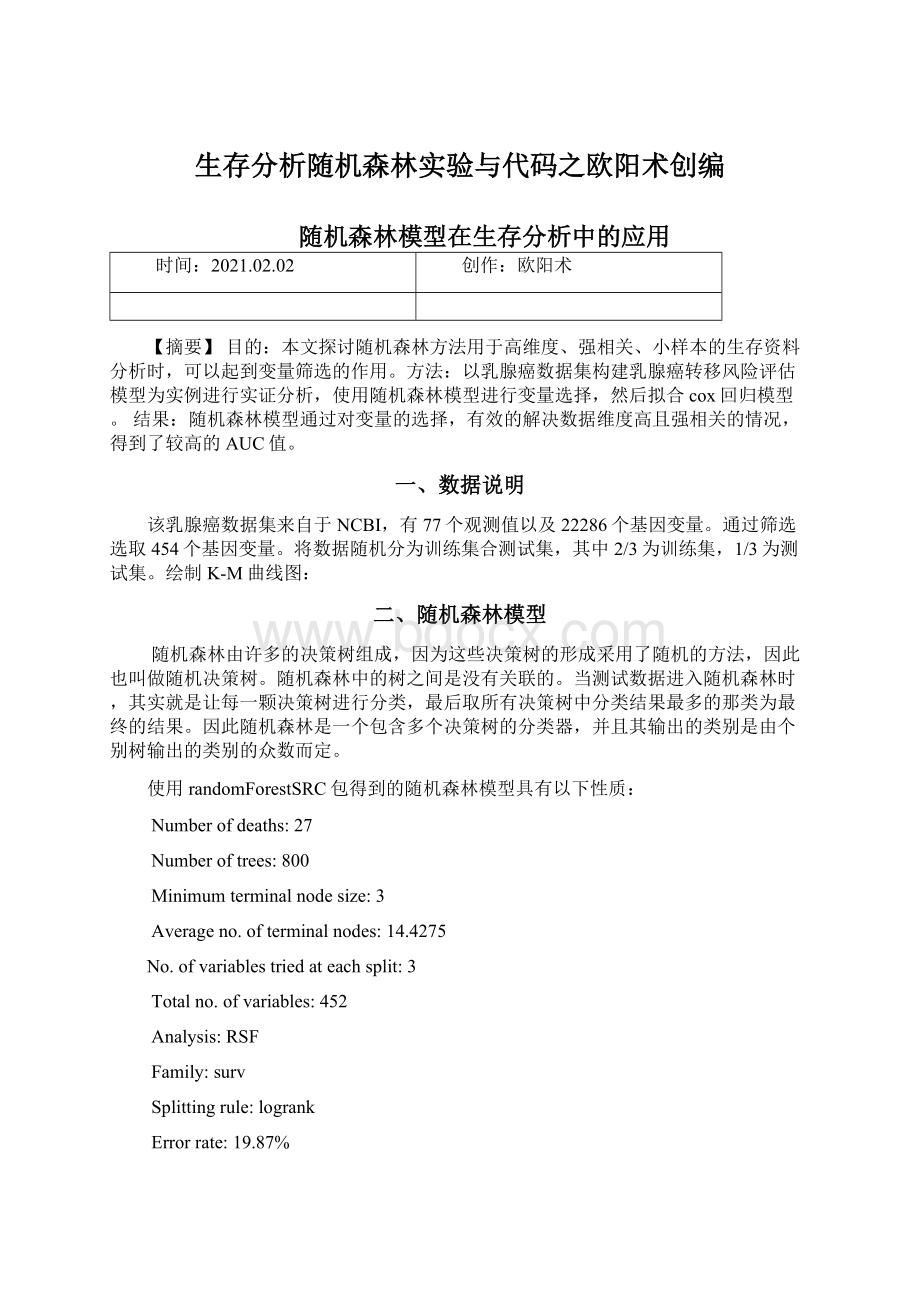生存分析随机森林实验与代码之欧阳术创编.docx
《生存分析随机森林实验与代码之欧阳术创编.docx》由会员分享,可在线阅读,更多相关《生存分析随机森林实验与代码之欧阳术创编.docx(6页珍藏版)》请在冰豆网上搜索。

生存分析随机森林实验与代码之欧阳术创编
随机森林模型在生存分析中的应用
时间:
2021.02.02
创作:
欧阳术
【摘要】目的:
本文探讨随机森林方法用于高维度、强相关、小样本的生存资料分析时,可以起到变量筛选的作用。
方法:
以乳腺癌数据集构建乳腺癌转移风险评估模型为实例进行实证分析,使用随机森林模型进行变量选择,然后拟合cox回归模型。
结果:
随机森林模型通过对变量的选择,有效的解决数据维度高且强相关的情况,得到了较高的AUC值。
一、数据说明
该乳腺癌数据集来自于NCBI,有77个观测值以及22286个基因变量。
通过筛选选取454个基因变量。
将数据随机分为训练集合测试集,其中2/3为训练集,1/3为测试集。
绘制K-M曲线图:
二、随机森林模型
随机森林由许多的决策树组成,因为这些决策树的形成采用了随机的方法,因此也叫做随机决策树。
随机森林中的树之间是没有关联的。
当测试数据进入随机森林时,其实就是让每一颗决策树进行分类,最后取所有决策树中分类结果最多的那类为最终的结果。
因此随机森林是一个包含多个决策树的分类器,并且其输出的类别是由个别树输出的类别的众数而定。
使用randomForestSRC包得到的随机森林模型具有以下性质:
Numberofdeaths:
27
Numberoftrees:
800
Minimumterminalnodesize:
3
Averageno.ofterminalnodes:
14.4275
No.ofvariablestriedateachsplit:
3
Totalno.ofvariables:
452
Analysis:
RSF
Family:
surv
Splittingrule:
logrank
Errorrate:
19.87%
发现直接使用随机森林得到的模型,预测误差很大,达到了19.8%,进一步考虑使用随机森林模型进行变量选择,结果如下:
>our.rf$rfsrc.refit.obj
Samplesize:
52
Numberofdeaths:
19
Numberoftrees:
500
Minimumterminalnodesize:
2
Averageno.ofterminalnodes:
11.554
No.ofvariablestriedateachsplit:
3
Totalno.ofvariables:
9
Analysis:
RSF
Family:
surv
Splittingrule:
logrank*random*
Numberofrandomsplitpoints:
10
Errorrate:
11.4%
>our.rf$topvars
[1]"213821_s_at""219778_at""204690_at""220788_s_at""202202_s_at"
[6]"211603_s_at""213055_at""219336_s_at""37892_at"
一共选取了9个变量,同时误差只有11.4%
接下来,使用这些变量做cox回归,剔除模型中不显著(>0.01)的变量,最终参与模型建立的变量共有4个。
模型结果如下:
exp(coef)exp(-coef)lower.95upper.95
`218150_at`1.65410.60460.1108624.6800
`200914_x_at`0.99151.00860.340942.8833
`220788_s_at`0.26493.77500.059441.1805
`201398_s_at`1.74570.57290.331099.2038
`201719_s_at`2.47080.40470.938086.5081
`202945_at`0.41182.42840.039904.2499
`203261_at`3.15020.31740.3364129.4983
`203757_s_at`0.78611.27200.616561.0024
`205068_s_at`0.10739.31800.022230.5181
最后选取六个变量拟合生存模型,绘制生存曲线如下:
下面绘制ROC曲线,分别在训练集和测试集上绘制ROC曲线,结果如下:
训练集:
测试集:
由于测试集上的样本过少,所以得到的AUC值波动大,考虑使用bootstrap多次计算训练集上的AUC值并求平均来测试模型的效果:
AUCat1year:
0.8039456
AUCat3year:
0.6956907
AUCat5year:
0.7024846
由此可以看到,随机森林通过删除贡献较低的变量,完成变量选择的工作,在测试集上具有较高的AUC值,但是比lasso-cox模型得到的AUC略低。
附录:
load("~/R/brea.rda")
library(survival)
set.seed(10)
i<-sample(1:
77,52)
train<-dat[i,]
test<-dat[-i,]
library(randomForestSRC)
disease.rf<-rfsrc(Surv(time,status)~.,data=train,
ntree=800,mtry=3,
nodesize=3,splitrule="logrank")
disease.rf
our.rf<-var.select(object=disease.rf,vdv,
method="vh.vimp",nrep=50)
our.rf$rfsrc.refit.obj
our.rf$topvars
index<-numeric(var.rf$modelsize)
for(iin1:
var.rf$modelsize){
index[i]<-which(names(dat)==var.rf$topvars[i])
}
data<-dat[,c(1,2,index)]
i<-sample(1:
77,52)
train<-data[i,]
test<-data[-i,]
mod.brea<-coxph(Surv(time,status)~.,data=train)
train_data<-train[,c(1,2,which(summary(mod.brea)$coefficients[,5]<=0.1)+2)]
tset_data<-test[,c(1,2,which(summary(mod.brea)$coefficients[,5]<=0.1)+2)]
mod.brea1<-coxph(Surv(time,status)~.,data=train_data)
summary(mod.brea1)
names(coef(mod.brea1))
plot(survfit(mod.brea1),xlab="Time",ylab="Proportion",main="CoxModel",conf.int=TRUE,col=c("black","red","red"),ylim=c(0.6,1))
index0<-numeric(length(coef(mod.brea1)))
coefficients<-coef(mod.brea1)
name<-gsub("\`","",names(coefficients))
for(jin1:
length(index0)){
index0[j]<-which(names(dat)==name[j])
}
library(survivalROC)
riskscore<-as.matrix(dat[i,index0])%*%as.matrix(coefficients)
y1<-survivalROC(Stime=train$time,status=train$status,marker=riskscore,predict.time=1,span=0.25*(nrow(train))^(-0.20))
y3<-survivalROC(Stime=train$time,status=train$status,marker=riskscore,predict.time=3,span=0.25*(nrow(train))^(-0.20))
y5<-survivalROC(Stime=train$time,status=train$status,marker=riskscore,predict.time=5,span=0.25*(nrow(train))^(-0.20))
a<-matrix(data=c("y1","y3","y5",y1$AUC,y3$AUC,y5$AUC),nrow=3,ncol=2);a
plot(y1$FP,y1$TP,type="l",xlab="FalsePositiveRate",ylab="TruePositiveRate",main="Time-dependentROCcurve",col="green")
lines(y3$FP,y3$TP,col="red",lty=2)
lines(y5$FP,y5$TP,col="blue",lty=3)
legend("bottomright",bty="n",legend=c("AUCat1year:
0.9271","AUCat3years:
0.8621","AUCat5years:
0.8263"),col=c("green","red","blue"),lty=c(1,2,3),cex=0.9)
abline(0,1)
riskscore<-as.matrix(dat[-i,index0])%*%as.matrix(coefficients)
y1<-survivalROC(Stime=test$time,status=test$status,marker=riskscore,predict.time=1,span=0.25*(nrow(train))^(-0.20))
y3<-survivalROC(Stime=test$time,status=test$status,marker=riskscore,predict.time=3,span=0.25*(nrow(train))^(-0.20))
y5<-survivalROC(Stime=test$time,status=test$status,marker=riskscore,predict.time=5,span=0.25*(nrow(train))^(-0.20))
a<-matrix(data=c("y1","y3","y5",y1$AUC,y3$AUC,y5$AUC),nrow=3,ncol=2);a
plot(y1$FP,y1$TP,type="l",xlab="FalsePositiveRate",ylab="TruePositiveRate",main="Time-dependentROCcurve",col="green")
lines(y3$FP,y3$TP,col="red",lty=2)
lines(y5$FP,y5$TP,col="blue",lty=3)
legend("bottomright",bty="n",legend=c("AUCat1year:
0.8761","AUCat3years:
0.7611","AUCat5years:
0.7611"),col=c("green","red","blue"),lty=c(1,2,3),cex=0.9)
abline(0,1)
a<-matrix(0,30,3)
for(cin1:
30){
i<-sample(1:
77,52)
train<-data[i,]
test<-data[-i,]
mod.brea<-coxph(Surv(time,status)~.,data=train)
train_data<-train[,c(1,2,which(summary(mod.brea)$coefficients[,5]<=0.1)+2)]
tset_data<-test[,c(1,2,which(summary(mod.brea)$coefficients[,5]<=0.1)+2)]
mod.brea1<-coxph(Surv(time,status)~.,data=train_data)
names(coef(mod.brea1))
index0<-numeric(length(coef(mod.brea1)))
coefficients<-coef(mod.brea1)
name<-gsub("\`","",names(coefficients))
for(jin1:
length(index0)){
index0[j]<-which(names(dat)==name[j])
}
riskscore<-as.matrix(dat[-i,index0])%*%as.matrix(coefficients)
y1<-survivalROC(Stime=test$time,status=test$status,marker=riskscore,predict.time=1,span=0.25*(nrow(train))^(-0.20))
y3<-survivalROC(Stime=test$time,status=test$status,marker=riskscore,predict.time=3,span=0.25*(nrow(train))^(-0.20))
y5<-survivalROC(Stime=test$time,status=test$status,marker=riskscore,predict.time=5,span=0.25*(nrow(train))^(-0.20))
a[c,]<-c(y1$AUC,y3$AUC,y5$AUC)
}
时间:
2021.02.02
创作:
欧阳术